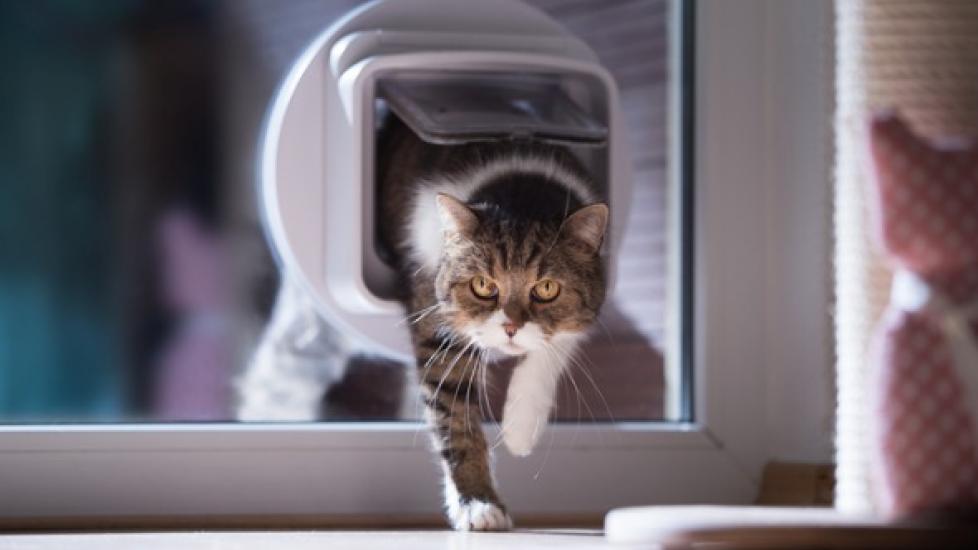Why You Might Actually Need a Cat Door
Image via iStock.com/Nils Jacobi
By Rebecca Desfosse
Does your indoor/outdoor cat scratch at the door to come in or yearn for more time outside? Or maybe you need an easy way to separate a larger pet from your cat during mealtime. Cat doors might be able to help in these situations.
When you first think of a cat door, you probably think of a little flap at the bottom of a door that lets a pet come in and go out of your house. But there are a multitude of options when it comes to pet doors for cats, including those that you can install in a wall inside your home. There are some cat doors with electronic locks and those that can be operated from an app on your phone. Here’s everything you need to know about cat flaps for your home.
Why You Might Need a Cat Door
Cat doors offer an excellent option for pet parents who want to manage their pet’s access to areas inside and outside the home. “Multi-animal households can benefit from cat doors, as they can allow for increased management or separation, as needed,” says Jessica Gore, animal behaviorist and owner of Competent Pup.
For example, a cat door can allow your cat to access their cat litter box without being disturbed by a nosy dog. A small door can also provide a valuable escape route for a cat, while preventing a larger pet from passing through.
Cat doors are also useful for introducing a new pet to your household. According to Russell Hartstein, cat behavioralist and founder of Fun Paw Care, a cat door allows a new kitty her own space, but gives her the option of gradually exploring her new environment. Cat flaps are also handy if there is cat aggression or other behavior problems that require control of different areas in the home.
According to Gore, “Cat doors can provide increased life enrichment opportunities as well.” For example, if you want to give your cat access to your study or office when you leave, but have the door shut to keep in heat or A/C, a cat door is a great and effective compromise.
Consider Your Cat’s Personality—and Safety
Shy cats may benefit from the added privacy and limited access that a cat door can provide. “Maybe you would like to allow a hiding space in your closet without having the door open all the time,” suggests Gore. On the other hand, an adventurous but responsible cat would benefit from having a cat door only he may use to explore the home, while other animals who are not granted the same access are kept contained.
A cat door can also let your kitty explore the great outdoors. “Indoor/outdoor cats who are trained not to venture off and who can remain supervised may benefit from the life enrichment provided by a cat door that leads to the outside,” says Gore. Just always keep your cat’s safety in mind and supervise her while she is outside.
Types of Cat Doors
Today, you can find a variety of cat doors on the market. Some cat doors, like the PetSafe 2-Way locking cat door, are intended for a wall or door inside the home. For use on the outside of the home, products like the Ideal Pet Products Designer Series original plastic pet door come with a lock-out, slide-in panel to keep pets inside at night or when you’re out running errands.
Other cat flaps, like the Cat Mate large cat/small dog 4-way self-lining door, provide a four-way locking system that allows you to choose between open, closed, in-access only and out-access only. Advancements in smart technology have also made a wide array of features available for electronic pet doors, such as key fobs or microchip access that only allow certain pets to go through the door, and even cat doors you can operate with an app on your phone.
Whatever cat door you choose, some silicone caulk and high-density foam will go a long way in saving on your electric bill. The PetSafe pet door installation kit contains everything you need for a completely airtight installation.
How to Train Your Cat to Use a Cat Door
While some cats take to the cat door right away, others may need some guidance. Either way, make it a fun, positive experience for them by using cat treats or cat toys when you first introduce the concept. “As always, use positive reinforcement when training your cat,” reminds Hartstein.
First, take off the cat door flap and show your pet how to go through the door. “You can situate yourself on the other side of the door, away from them, and encourage them through, offering their favorite things in return for their participation and bravery,” says Gore. Do this a few times, and then work up to implementing the barrier. Cat doors that require your kitty to push through require a little more training.
The rewards for training your kitty to use the cat flap are more than worth it—for both you and your cat.
